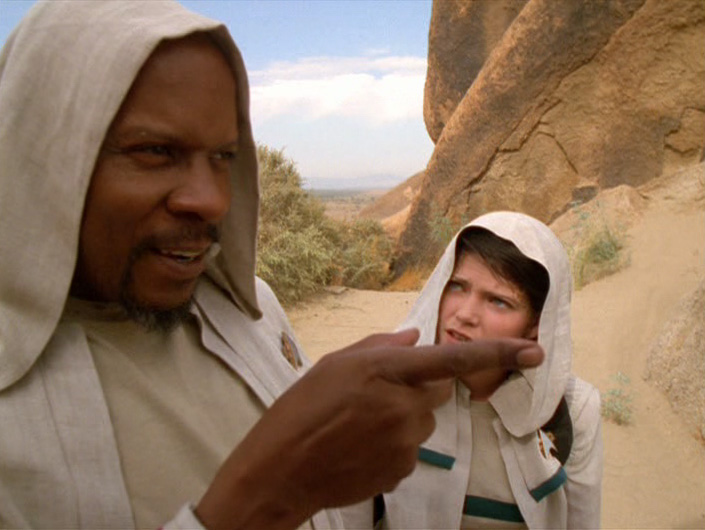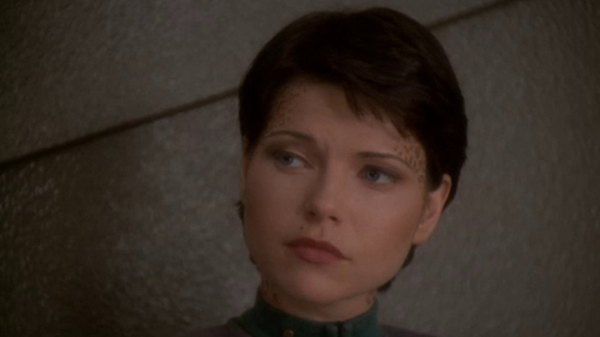“SHADOWS AND SYMBOLS”
You don’t have to be crazy to work here, but it helps.
“Shadows and Symbols” brings this season-spanning trilogy to a close and, while it’s been a bumpy and uneven ride, I’m happy to say that things end on a high. Ira Behr and Hans Beimler’s script adeptly balances all the plot elements and builds to a genuinely exhilarating finale, while Allan Kroeker does a superb job on the directorial front. In fact, this is hands down the strongest episode of DS9 since “In the Pale Moonlight”. While certainly not on that episode’s level, it’s nevertheless an engaging, intriguing and ultimately rewarding hour. That said, I do think that “Image in the Sand” and “Shadows and Symbols” may have worked better as a single, feature-length episode rather than a two-parter.
The episode begins by introducing us to our new Dax, Ezri, so that’s where I’ll begin as well. On the whole, I thought the character was well introduced and Nicole deBoer immediately charms with an engaging and amiable performance that subtly recalls some of Jadzia’s mannerisms while establishing a very different tone of character. It’s interesting to see Dax go from confident, assured and comfortable in her own skin to...well, basically a neurotic misfit. Fortunately, she’s also rather endearing (although the space sick gag decidedly less so). Alas, if there’s any disappointment it’s that Avery Brooks lacks the chemistry with deBoer he enjoyed with Terry Farrell, and I expected more emotion upon Sisko meeting his third incarnation of Dax. I guess Ben was preoccupied with his mission to Tyree, and then, when they get there, he slips into full-blown whack-a-doodle mode. Still, I liked the way Ezri’s presence didn’t dominate the episode but rather added to it. I think my biggest complaint is the closing scene where she reunites with her old comrades on the station (seemingly forgetting the Trill reassociation taboo, I might add) and her first words to Worf are an offhand, dismissive “Worf, we need to talk.” Geez, given that her last memory as Jadzia is dying in Worf’s arms, you’d think she’d have a little more emotion at seeing her former husband again. I know the writers are going to explore the relationship more fully in the following episode, but it’s still a monumentally insensitive moment. Worf’s reaction is wholly understandable.
Onto the plot/s! The main storyline features Sisko’s obsessive quest to find the Orb of the Emissary. It makes for an entertaining romp and is bolstered by a surprise call-back to last season’s “Far Beyond the Stars”. Revisiting Benny Russell was a genuine surprise and works extremely well, with Benny furiously scribbling the entire story of DS9 on the walls of an insane asylum. As enjoyable as it is, this storyline doesn’t bear a huge amount of scrutiny. Coincidence abounds, and we’re never quite sure
why there’s a Bajoran orb buried in the desert on some alien planet, and why it contains a Prophet who requires someone to open the orb in order to shoot toward the wormhole and destroy the Kosst Amojan Pah-Wraith. I guess you could surmise that the Prophets foresaw all this happening so set the whole thing up in advance. But, really, why was Sisko even necessary when all he did was
open a box. Couldn’t
anyone have done that?
In fact, couldn’t the Prophet have slipped through the crack or something? As I’ve said before, I do like the mythology of two battling races of extra-dimensional beings, yet I can’t help but think Ira Behr and co have only sketched out the barest of outlines. There are some cool ideas—the quest for a previously unknown orb and the Pah-wraiths trying to stop Sisko with a false vision—although the way the orb magically resets everything is just a little too...I dunno, easy.
(Another nit: how did Kosst Amojan go from being forced out of Jake’s body in “The Reckoning” to being stuck within the statue that Dukat broke open in “Tears of the Prophets”?)
The revelation that the Prophets arranged Sisko’s birth wasn’t all that much of a surprise to me given the way the series was going. The ethics of how they did it, however, certainly raise an eyebrow. Basically, they possess a woman named Sarah, get her to hook up with Joseph Sisko and make sure that she becomes pregnant and gives birth to baby Benjamin, before discarding her (and we find out that she evidently died of an accident not long after, which made me wonder if it really
was an “accident”!). Sucks to be Sarah, huh? The Q truly have nothing on these guys. I also wonder why they needed their Emissary to have Sarah’s specific DNA? What difference does that make? Why couldn’t they have chosen the child that would likely later have been born of Joseph and his subsequent wife? This is kind of LOST-style storytelling in which each new revelation comes with a dozen new questions, most of which never receive answers.
Nevertheless, by restoring the Prophets, Sisko gets his mojo back and returns to the station with Ezri in tow. Before I move on, one particular disappointment I had with the storyline was the way poor Joseph was sidelined. I felt rather sorry for Brock Peters being dragged along on the location shooting (it looked uncomfortably HOT, as DS9 location shooting often is) only to deliver two short lines of dialogue at most. Given this is the final time we see the character, I feel he was short-changed. It’s only natural that Ezri would receive primary focus, but it’s sad that it was at the expense of the delightful Joseph Sisko.
The B-plot features Kira in true badass mode, taking a stand against both the Romulans and Admiral Ross as she blockades the moon of Durna. It’s a nice acknowledgement that Bajoran interests may not always align with Starfleet interests, a conflict we’ve never really seen since the early second season and the Circle coup. It’s great fun to see Kira at her passionate, resilient and obstinate best, back to defending her world against (potential) alien oppressors with Odo supporting her every step of the way, not so much as a security chief, but as her lover and best friend. Thanks largely to Nana Visitor’s fiery performance and the brilliant directing of Allan Kroeker, which elevates the entire episode, these scenes are nicely tense, even if the outcome is never really in doubt. I rather wish we’d seen more of Senator Cretak (although if I recall she does make one more, recast appearance by the end of the season), as it would have been interesting to where her relationship with Kira went after this.
The final storyline features Worf’s mission to earn Jadzia a place in Sto’Vo’Kor. There’s not a whole lot to this, and some of the special effects are surprisingly disappointing, but it’s enlivened by sparky, engaging characterisation, with Quark nabbing all the best lines. Again, I felt Jadzia’s death was shortchanged in general, and I wasn’t particularly moved by any of this, but it’s decent enough and provides Worf with some closure—at least, until he gets back to the station, that is.
“Shadows and Symbols” is an episode that definitely picks up the pace. It has a lot to do in the space of forty-five minutes, but it does so admirably, on the whole. While certain story elements feel a little arbitrary and sketchy, it’s executed with such panache that I can forgive a fair bit. Ira Behr and Hans Beimler deliver one of their tightest, wittiest scripts in considerable time, and Allan Kroeker’s directing is perfect, cultivating a superb sense of pace and rhythm that culminates in a truly exhilarating climax. On the whole, I’d consider this a fairly strong start to the season.
Rating: 8









